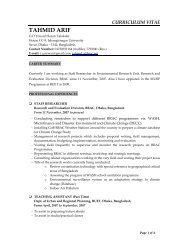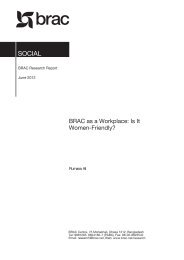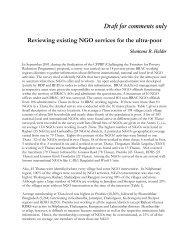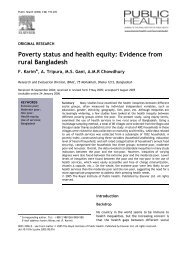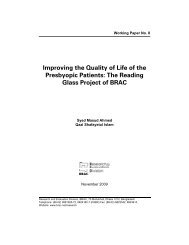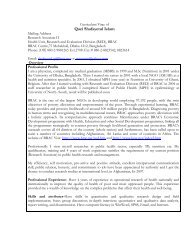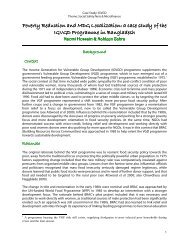Combining health and social protection measures to reach the ultra ...
Combining health and social protection measures to reach the ultra ...
Combining health and social protection measures to reach the ultra ...
Create successful ePaper yourself
Turn your PDF publications into a flip-book with our unique Google optimized e-Paper software.
Decision-making<br />
Low- <strong>and</strong> middle-income countries<br />
High-income countries<br />
Cause Deaths Cause Deaths<br />
(millions)<br />
(millions)<br />
1 Perinatal conditions 2.49 20.7% 1 Perinatal conditions 0.03 33.9%<br />
2 Lower respira<strong>to</strong>ry infections 2.04 17.0% 2 Congenital anomalies 0.02 20.0%<br />
3 Diarrhoeal diseases 1.61 13.4% 3 Road traffic accidents 0.01 5.9%<br />
4 Malaria 1.10 9.2% 4 Lower respira<strong>to</strong>ry infections 0.00 2.5%<br />
5 Measles 0.74 6.2% 5 Endocrine disorders 0.00 2.4%<br />
6 HIV/AIDS 0.44 3.7% 6 Drownings 0.00 2.4%<br />
7 Congenital anomalies 0.44 3.7% 7 Leukemia 0.00 1.9%<br />
8 Whooping cough 0.30 2.5% 8 Violence 0.00 1.8%<br />
9 Tetanus 0.22 1.9% 9 Fires 0.00 1.2%<br />
10 Road traffic accidents 0.18 1.5% 10 Meningitis* 0.00 1.2%<br />
Table 4: The 10 leading causes of death in children aged 0–14, by broad income group, 2001<br />
60 <strong>and</strong> over in all regions. Globally, 60-year-olds have a 55%<br />
chance of dying before <strong>the</strong>ir 70th birthday. Regional variations<br />
in <strong>the</strong> risk of death are smaller at older ages than at younger<br />
ages, ranging from around 40% in <strong>the</strong> developed countries of<br />
Western Europe <strong>to</strong> 60% in most developing regions <strong>and</strong> 70%<br />
in sub-Saharan Africa. His<strong>to</strong>rical data from countries such as<br />
Australia <strong>and</strong> Sweden show that life expectancy at age 60<br />
changed slowly during <strong>the</strong> first six <strong>to</strong> seven decades of <strong>the</strong><br />
20th century, but started <strong>to</strong> increase substantially since<br />
around 1970. Life expectancy at age 60 has now <strong>reach</strong>ed 25<br />
years in Japan. In Eastern Europe from 1990 onwards,<br />
Hungary, <strong>and</strong> Pol<strong>and</strong> started <strong>to</strong> experience similar<br />
improvements in mortality for older people, but Russia has<br />
not, <strong>and</strong> is actually experiencing a worsening trend.<br />
Regional variations in causes of death<br />
The 10 leading causes of mortality differ greatly between<br />
regions (Table 6). IHD <strong>and</strong> cerebrovascular disease are<br />
among <strong>the</strong> <strong>to</strong>p four causes of death in all low- <strong>and</strong> middleincome<br />
regions except sub-Saharan Africa, where <strong>the</strong>y are<br />
8th <strong>and</strong> 7th, respectively. Cerebrovascular disease is <strong>the</strong><br />
leading cause of death in East Asia <strong>and</strong> <strong>the</strong> Pacific, unlike in<br />
most o<strong>the</strong>r regions, where IHD causes more deaths than<br />
cerebrovascular disease. In sub-Saharan Africa, 6 of <strong>the</strong> <strong>to</strong>p<br />
10 causes are communicable diseases, with HIV/AIDS being<br />
<strong>the</strong> leading cause of death, followed by malaria <strong>and</strong> lower<br />
respira<strong>to</strong>ry infections.<br />
South Asia (mainly India) <strong>and</strong> Latin America <strong>and</strong> <strong>the</strong><br />
Caribbean are <strong>the</strong> only two o<strong>the</strong>r low- <strong>and</strong> middle-income<br />
regions where HIV/AIDS is one of <strong>the</strong> <strong>to</strong>p 10 causes of death.<br />
Lower respira<strong>to</strong>ry infections, primarily pneumonia, are <strong>the</strong><br />
third leading cause of death, especially among children<br />
under five, who account for 60% of <strong>the</strong>se deaths. Chronic<br />
obstructive pulmonary disease kills more people (1.4 million)<br />
in <strong>the</strong> East Asia <strong>and</strong> Pacific region, primarily China, than<br />
anywhere else in <strong>the</strong> world, with 50% of global mortality<br />
from <strong>the</strong> disease occurring <strong>the</strong>re.<br />
Europe <strong>and</strong> Central Asia differs from all o<strong>the</strong>r low- <strong>and</strong><br />
middle-income regions in <strong>the</strong> size of <strong>the</strong> CVD epidemic (with<br />
almost 60% of deaths due <strong>to</strong> CVD), followed by trachea,<br />
bronchus, <strong>and</strong> lung cancers in third place. Self-inflicted injuries<br />
(suicide) are <strong>the</strong> fifth leading cause of death in this region.<br />
South Asia is <strong>the</strong> only o<strong>the</strong>r region where suicide is in <strong>the</strong> <strong>to</strong>p<br />
10 causes of death. Latin America <strong>and</strong> <strong>the</strong> Caribbean is<br />
distinguished as <strong>the</strong> only region where violence falls in <strong>the</strong> <strong>to</strong>p<br />
10 causes of death, responsible for 1 in 25 deaths. In all low<strong>and</strong><br />
middle-income regions apart from Europe <strong>and</strong> Central Asia,<br />
road traffic accidents are included among <strong>the</strong> <strong>to</strong>p 10 causes of<br />
death, <strong>reach</strong>ing fifth position in <strong>the</strong> Middle East <strong>and</strong> North<br />
Africa, where <strong>the</strong>y are responsible for 1 in 20 deaths.<br />
Global burden of disease in 2001<br />
The 20 leading causes of burden of disease for both sexes<br />
<strong>to</strong>ge<strong>the</strong>r are shown in Table 7. While <strong>the</strong> two leading causes<br />
Low- <strong>and</strong> middle-income countries<br />
High-income countries<br />
Cause Deaths Cause Deaths<br />
(millions)<br />
(millions)<br />
1 HIV/AIDS 2.05 14.1% 1 Ischaemic heart disease 0.13 10.8%<br />
2 Ischaemic heart disease 1.18 8.1% 2 Self-inflicted injuries 0.09 7.2%<br />
3 Tuberculosis 1.03 7.1% 3 Road traffic accidents 0.08 6.9%<br />
4 Road traffic accidents 0.73 5.0% 4 Trachea, bronchus, lung cancers 0.08 6.8%<br />
5 Cerebrovascular disease 0.71 4.9% 5 Cerebrovascular disease 0.05 4.4%<br />
6 Self-inflicted injuries 0.58 4.0% 6 Cirrhosis of <strong>the</strong> liver 0.05 4.4%<br />
7 Violence 0.45 3.1% 7 Breast cancer 0.05 4.0%<br />
8 Lower respira<strong>to</strong>ry infections 0.33 2.3% 8 Colon <strong>and</strong> rectum cancers 0.04 3.1%<br />
9 Cirrhosis of <strong>the</strong> liver 0.32 2.2% 9 Diabetes mellitus 0.03 2.1%<br />
10 Chronic obstructive<br />
pulmonary disease 0.32 2.2% 10 S<strong>to</strong>mach cancer 0.02 2.0%<br />
Table 5: The 10 leading causes of death in adults aged 15–59, by broad income group, 2001<br />
170 ✜ Global Forum Update on Research for Health Volume 4




